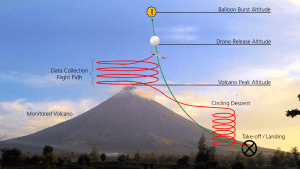In theory, the scientific concept behind our project is simple. We want to eliminate the “GPE=mgh” energy expended by the drone in climbing altitude, so as to improve the energy efficiency of the volcano surveillance operation. With the use of the helium balloon to increase the altitude of the drone to 3000 m, we could potentially save up an estimated 100,000 joules of energy for a 3.5 kg drone, making each mission more energy efficient.
Executing the proof of concept
Owing to the nature and scale of our project and the geological limitations of Singapore (no volcanoes), it is very likely that our prototype needs to be tested overseas. However, prior to that, we did a smaller scale test in Singapore first, to show that our idea was actually possible, before expending resources doing it overseas.
Local testing
Due to the lack of volcanoes and stringent drone flying/balloon release laws in Singapore, we had many constraints with respect to testing our proof of concept locally. Firstly, Civil Aviation Authorities Singapore (CAAS) laws require all weather balloons deployed to be tethered to the ground, which is different from what we had in mind (to let the balloon fly up freely on its own). CAAS also have very strict laws with regards to ‘discharging substances’ from flying drones, which is also linked to what we were doing. Furthermore, drones were not allowed to fly above 60 m. Our balloon-drone hybrid fell within a grey area of these laws, as technically we were discharging a drone from a balloon. We had to submit multiple emails/proposals and phone calls to clarify what we were doing to obtain the necessary approvals.
In the end, we have managed to arrive at an arrangement with CAAS with respect to testing our proof of concept locally. We promised to use 2 tethers to hold the balloon down, and on top of that, we attached a balloon shredder (designed by Kanesh) on the balloon. The device is remotely controlled from the ground, and in the very unlikely event both tethers fail, we will press the detonator to pop the balloon. Also, we promised to keep our balloon max height at 60 m to comply with drone flying laws, but this also meant we had less height to play around with and a smaller room for error.

Overseas testing
With regards to overseas testing, throughout the course of the project, we have been researching on possible locations where we can test our proof of concept. We plan to test our prototype out in Indonesia, due to the abundance of volcanoes and the contacts Prof Benoit has there. Our 3 main priorities in volcano selection are
(1) Accessibility
The surrounding locality around the volcano should not contain densely populated areas, and should ideally have a lot of clearings where we can set up our base camp and launch site. But also, not too remote that no roads pass through the area. There should also be no large bodies of water around the volcano. This is primarily for safety reasons, because in the event we lost control of the plane, we want to minimise the damage caused by the crashing plane, and ideally, be able to salvage as many plane parts as we can.
(2) Volcano activity
Ideally, we want to select a volcano with mild activity, so as to better showcase of prototype, but also, not compromise the safety of all our members of the team. Hence, our team only shortlisted potential volcanoes with alert level 2 and below.
(3) Air traffic
The airspace volcano of choice should ideally not have any commercial or military aircraft flying through, as our balloon might get in the way of their flight paths.

After which, we drafted a proposal to be submitted to Indonesia civil aviation authorities, drone association and volcano organisation. Hopefully, it will get approval soon!
Modelling balloon burst altitude and flight path
After shortlisting a few volcanoes, balloon predictions for the various volcanoes were also done using balloon flight modelling software habhub.com. This enabled us to determine the optimal launch sites near to the respective volcanoes. The elevator profile of the balloon also helped us determine the altitude in which the release mechanism should be triggered (i.e. when the glider should detach itself from the balloon). Nonetheless, the balloon modelling will need to be done repeatedly closer to the day where we intend to launch the balloon since it is dependent on the wind directions on that day.

However, like all sciences, the practical aspect is never so simple! The toughest part of our project was to actually fixing up, calibrating and carrying out successful balloon drop tests. We will share more of this under the ‘Development’ section!
